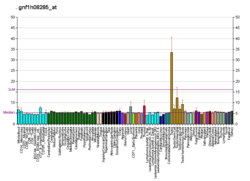HEXIM2
Protein HEXIM2 is a protein that in humans is encoded by the HEXIM2 gene.[5][6]
References
- 1 2 3 GRCh38: Ensembl release 89: ENSG00000168517 - Ensembl, May 2017
- 1 2 3 GRCm38: Ensembl release 89: ENSMUSG00000043372 - Ensembl, May 2017
- ↑ "Human PubMed Reference:".
- ↑ "Mouse PubMed Reference:".
- ↑ Michels AA, Nguyen VT, Fraldi A, Labas V, Edwards M, Bonnet F, Lania L, Bensaude O (Jun 2003). "MAQ1 and 7SK RNA interact with CDK9/cyclin T complexes in a transcription-dependent manner". Mol Cell Biol. 23 (14): 4859–69. doi:10.1128/MCB.23.14.4859-4869.2003. PMC 162212. PMID 12832472.
- ↑ "Entrez Gene: HEXIM2 hexamthylene bis-acetamide inducible 2".
Further reading
- Strausberg RL, Feingold EA, Grouse LH, et al. (2003). "Generation and initial analysis of more than 15,000 full-length human and mouse cDNA sequences". Proc. Natl. Acad. Sci. U.S.A. 99 (26): 16899–903. doi:10.1073/pnas.242603899. PMC 139241. PMID 12477932.
- Ota T, Suzuki Y, Nishikawa T, et al. (2004). "Complete sequencing and characterization of 21,243 full-length human cDNAs". Nat. Genet. 36 (1): 40–5. doi:10.1038/ng1285. PMID 14702039.
- Beausoleil SA, Jedrychowski M, Schwartz D, et al. (2004). "Large-scale characterization of HeLa cell nuclear phosphoproteins". Proc. Natl. Acad. Sci. U.S.A. 101 (33): 12130–5. doi:10.1073/pnas.0404720101. PMC 514446. PMID 15302935.
- Petroziello J, Yamane A, Westendorf L, et al. (2004). "Suppression subtractive hybridization and expression profiling identifies a unique set of genes overexpressed in non-small-cell lung cancer". Oncogene. 23 (46): 7734–45. doi:10.1038/sj.onc.1207921. PMID 15334068.
- Yik JH, Chen R, Pezda AC, Zhou Q (2005). "Compensatory contributions of HEXIM1 and HEXIM2 in maintaining the balance of active and inactive positive transcription elongation factor b complexes for control of transcription". J. Biol. Chem. 280 (16): 16368–76. doi:10.1074/jbc.M500912200. PMID 15713661.
- Byers SA, Price JP, Cooper JJ, et al. (2005). "HEXIM2, a HEXIM1-related protein, regulates positive transcription elongation factor b through association with 7SK". J. Biol. Chem. 280 (16): 16360–7. doi:10.1074/jbc.M500424200. PMID 15713662.
- Li Q, Price JP, Byers SA, et al. (2005). "Analysis of the large inactive P-TEFb complex indicates that it contains one 7SK molecule, a dimer of HEXIM1 or HEXIM2, and two P-TEFb molecules containing Cdk9 phosphorylated at threonine 186". J. Biol. Chem. 280 (31): 28819–26. doi:10.1074/jbc.M502712200. PMID 15965233.
- Fraldi A, Varrone F, Napolitano G, et al. (2006). "Inhibition of Tat activity by the HEXIM1 protein". Retrovirology. 2 (1): 42. doi:10.1186/1742-4690-2-42. PMC 1183248. PMID 15992410.
This article is issued from
Wikipedia.
The text is licensed under Creative Commons - Attribution - Sharealike.
Additional terms may apply for the media files.




